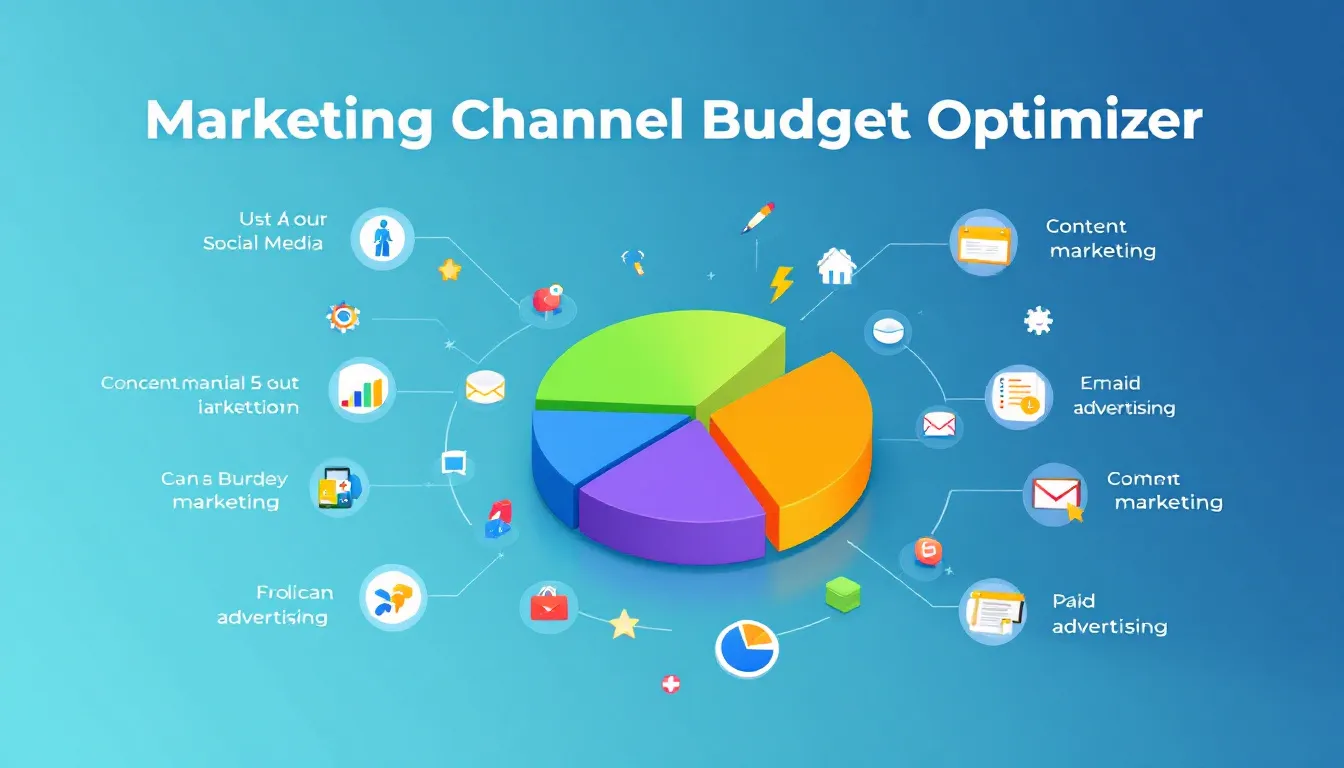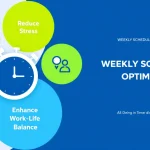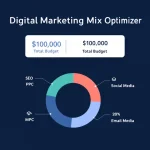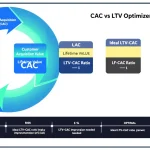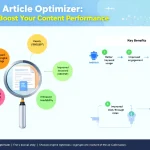Marketing Budget Allocation Tool
Generating results...
Is this tool helpful?
How to Use the Marketing Channel Strategy Budget Planner Effectively
Our Marketing Channel Strategy Budget Planner is designed to help marketers create comprehensive budget templates and resource allocation guides tailored to specific marketing channel strategies. To use this tool effectively, follow these steps:
- Specify Your Marketing Channel Strategy: Enter the specific marketing channel strategy you want to focus on. For example, you might input “Influencer Marketing” or “Programmatic Advertising”.
- Enter Your Total Marketing Budget: Input the total marketing budget available for allocation in USD. For instance, you could enter “250000” for a $250,000 budget.
- Define Your Primary Marketing Objectives: Clearly state your primary marketing objectives for the strategy. An example could be “Increase brand awareness among Gen Z consumers, drive user-generated content, and boost online sales by 30% in Q3”.
- Describe Your Target Audience (Optional): Provide details about your target audience’s demographics, interests, and behaviors. For instance, “Tech-savvy millennials aged 25-40, interested in sustainable fashion and online shopping”.
- Specify Your Industry Vertical (Optional): Enter your industry vertical or business sector. An example could be “Sustainable Fashion E-commerce”.
- Generate Your Budget Templates and Resource Allocation Guides: Click the “Generate Budget Templates and Resource Allocation Guides” button to receive tailored recommendations based on your inputs.
Once you’ve submitted the form, our AI-powered tool will generate comprehensive budget templates and resource allocation guides specifically tailored to your marketing channel strategy, objectives, and target audience.
Introduction to the Marketing Channel Strategy Budget Planner
In today’s complex marketing landscape, efficiently allocating resources across various channels is crucial for achieving optimal marketing mix and return on investment (ROI). Our Marketing Channel Strategy Budget Planner is a powerful tool designed to assist marketers, business owners, and strategic planners in creating data-driven, flexible budget templates and resource allocation guides tailored to specific marketing channel strategies.
This innovative tool leverages years of marketing expertise and best practices to provide a clear framework for budget allocation across digital and traditional marketing channels, emerging platforms, and data-driven decision-making processes. By using this planner, you can ensure that your marketing resources are distributed effectively, maximizing the impact of your campaigns and driving better results.
Purpose and Benefits
The primary purpose of our Marketing Channel Strategy Budget Planner is to streamline the process of creating comprehensive budget templates and resource allocation guides. It offers several key benefits:
- Tailored Recommendations: Receive customized budget allocation suggestions based on your specific marketing channel strategy, objectives, and target audience.
- Efficiency: Save time and resources by automating the creation of detailed budget templates and allocation guides.
- Flexibility: Obtain guidelines that allow for adjustments based on performance metrics and market changes.
- Optimization: Maximize your marketing ROI by efficiently distributing resources across various channels.
- Strategic Insights: Gain valuable insights into channel effectiveness and strategies for scaling successful campaigns.
Benefits of Using the Marketing Channel Strategy Budget Planner
1. Data-Driven Decision Making
Our budget planner incorporates industry best practices and data-driven insights to help you make informed decisions about resource allocation. By leveraging this tool, you can:
- Identify the most effective channels for your specific marketing objectives
- Allocate budgets based on historical performance data and industry benchmarks
- Optimize your marketing mix for maximum ROI
2. Time and Resource Savings
Creating comprehensive budget templates and resource allocation guides manually can be a time-consuming process. Our tool significantly reduces the time and effort required by:
- Automating the generation of tailored budget templates
- Providing instant recommendations based on your inputs
- Eliminating the need for extensive research and manual calculations
3. Flexibility and Adaptability
The marketing landscape is constantly evolving, and our budget planner is designed to accommodate these changes. Benefits include:
- Easily adjustable templates that can be modified based on performance metrics
- Guidance on reallocating budgets to maximize impact as market conditions change
- Adaptability to emerging platforms and new marketing channels
4. Comprehensive Channel Coverage
Our tool takes into account both digital and traditional marketing channels, ensuring a holistic approach to budget allocation. This comprehensive coverage allows you to:
- Explore a wide range of marketing channels and tactics
- Balance your investment across various touchpoints in the customer journey
- Identify opportunities in emerging platforms and innovative marketing techniques
5. Strategic Scaling Guidance
The Marketing Channel Strategy Budget Planner doesn’t just help with initial allocation; it also provides strategies for scaling successful campaigns. This feature enables you to:
- Identify high-performing channels and tactics
- Develop strategies for expanding successful campaigns
- Allocate additional resources effectively to maximize growth
Addressing User Needs and Solving Specific Problems
Our Marketing Channel Strategy Budget Planner addresses several key challenges faced by marketers and strategic planners:
1. Optimal Budget Allocation
One of the most significant challenges in marketing is determining how to allocate budgets across various channels for maximum impact. Our tool solves this problem by providing data-driven recommendations based on your specific strategy, objectives, and target audience.
For example, if you input a content marketing strategy focused on increasing brand awareness among B2B decision-makers, with a budget of $100,000, the tool might recommend the following allocation:
- Content Creation and Production: 40% ($40,000)
- Paid Social Media Promotion: 25% ($25,000)
- Search Engine Marketing: 20% ($20,000)
- Influencer Partnerships: 10% ($10,000)
- Email Marketing: 5% ($5,000)
This allocation takes into account the effectiveness of each channel for B2B content marketing and brand awareness objectives.
2. Performance Evaluation and Reallocation
Marketers often struggle with evaluating channel effectiveness and reallocating budgets based on performance. Our tool addresses this by providing guidance on key performance indicators (KPIs) to track and strategies for budget reallocation.
For instance, if your initial allocation for a social media advertising campaign shows that Instagram is outperforming Facebook in terms of engagement and conversion rates, the tool might suggest:
- Increase Instagram ad spend by 30%
- Decrease Facebook ad spend by 20%
- Reallocate the remaining 10% to testing new ad formats on Instagram
3. Incorporating Emerging Platforms
Keeping up with new marketing platforms and technologies can be challenging. Our budget planner helps solve this problem by providing recommendations on allocating resources to emerging channels based on your industry and target audience.
For example, if you’re in the fashion e-commerce sector targeting Gen Z consumers, the tool might suggest allocating 15% of your budget to TikTok marketing, even if you haven’t used this platform before, due to its high engagement rates among your target demographic.
4. Balancing Short-term and Long-term Objectives
Marketers often struggle to balance immediate results with long-term brand building. Our tool addresses this by providing allocation recommendations that consider both short-term and long-term marketing objectives.
For instance, for a SaaS company looking to drive immediate lead generation while also building brand awareness, the tool might recommend:
- 60% allocation to performance marketing channels (e.g., Google Ads, LinkedIn Ads) for immediate lead generation
- 30% allocation to content marketing and SEO for long-term brand building and organic growth
- 10% allocation to PR and thought leadership initiatives for industry credibility
Practical Applications and Use Cases
1. Launching a New Product
When launching a new product, effective budget allocation across various marketing channels is crucial. Here’s how our tool can help:
Scenario: A consumer electronics company is launching a new smart home device with a marketing budget of $500,000.
Tool Input:
- Marketing Channel Strategy: Product Launch
- Total Marketing Budget: $500,000
- Primary Marketing Objectives: Create product awareness, drive pre-orders, establish market position
- Target Audience: Tech-savvy homeowners, aged 30-55, interested in home automation and energy efficiency
- Industry Vertical: Consumer Electronics
Tool Output:
- Digital Advertising (Google Ads, Facebook, Instagram): 35% ($175,000)
- Influencer Partnerships: 20% ($100,000)
- PR and Media Relations: 15% ($75,000)
- Content Marketing (Blog posts, videos, infographics): 10% ($50,000)
- Email Marketing: 8% ($40,000)
- Trade Show and Event Marketing: 7% ($35,000)
- Affiliate Marketing: 5% ($25,000)
The tool also provides guidance on key performance indicators to track, such as pre-order numbers, website traffic, social media engagement, and press mentions.
2. Reallocation for a B2B Service Provider
B2B companies often need to adjust their marketing strategies based on performance data. Here’s how our tool can assist in budget reallocation:
Scenario: A B2B software company has been running a lead generation campaign for three months with a monthly budget of $50,000. They want to optimize their budget allocation based on performance data.
Tool Input:
- Marketing Channel Strategy: B2B Lead Generation
- Total Marketing Budget: $50,000 per month
- Primary Marketing Objectives: Increase qualified leads, improve cost per lead, boost conversion rates
- Target Audience: IT decision-makers in mid to large-sized enterprises
- Industry Vertical: Enterprise Software
Initial Allocation:
- LinkedIn Ads: 40% ($20,000)
- Google Ads: 30% ($15,000)
- Content Syndication: 20% ($10,000)
- Email Marketing: 10% ($5,000)
Performance Data: LinkedIn Ads and Email Marketing have shown the highest ROI, while Google Ads performance has been below expectations.
Tool Output (Reallocation Recommendation):
- LinkedIn Ads: 50% ($25,000) – Increase budget due to high performance
- Email Marketing: 20% ($10,000) – Double budget to capitalize on success
- Google Ads: 15% ($7,500) – Reduce budget and focus on optimizing campaigns
- Content Syndication: 10% ($5,000) – Maintain presence but reduce investment
- Account-Based Marketing: 5% ($2,500) – New channel to test for targeted outreach
The tool also provides recommendations for adjusting targeting, ad creatives, and landing pages to improve overall campaign performance.
3. Seasonal Campaign Planning
Seasonal campaigns require careful budget allocation to maximize impact during peak periods. Here’s how our tool can help plan a holiday marketing campaign:
Scenario: An e-commerce fashion retailer is planning their holiday season marketing campaign with a budget of $200,000 for November and December.
Tool Input:
- Marketing Channel Strategy: Holiday Season E-commerce Campaign
- Total Marketing Budget: $200,000
- Primary Marketing Objectives: Increase holiday sales, boost customer acquisition, maximize ROI during peak shopping periods
- Target Audience: Fashion-conscious consumers, aged 18-45, interested in online shopping and gift-giving
- Industry Vertical: Fashion E-commerce
Tool Output:
- Paid Social Media (Facebook, Instagram, Pinterest): 35% ($70,000)
- Google Shopping and Search Ads: 25% ($50,000)
- Influencer Marketing: 15% ($30,000)
- Email Marketing: 10% ($20,000)
- Retargeting Campaigns: 8% ($16,000)
- Content Marketing (Gift guides, lookbooks): 5% ($10,000)
- Affiliate Marketing: 2% ($4,000)
The tool also provides a timeline for campaign execution, suggesting when to increase ad spend (e.g., Black Friday, Cyber Monday, last shipping dates) and how to adjust messaging throughout the season.
Frequently Asked Questions (FAQ)
Q1: How often should I update my marketing channel strategy budget allocation?
A1: It’s recommended to review and update your budget allocation quarterly, or more frequently if you’re running short-term campaigns or operating in a rapidly changing market. Our tool allows for easy adjustments based on performance data and changing market conditions.
Q2: Can this tool help with allocating budgets for both B2B and B2C marketing strategies?
A2: Yes, our Marketing Channel Strategy Budget Planner is designed to cater to both B2B and B2C marketing strategies. The tool takes into account your specific industry vertical, target audience, and marketing objectives to provide tailored recommendations for either B2B or B2C contexts.
Q3: How does the tool account for emerging marketing channels?
A3: Our tool is regularly updated to include emerging marketing channels and platforms. It considers factors such as your target audience demographics, industry trends, and marketing objectives to recommend allocations to new channels that may be effective for your specific strategy.
Q4: Can I use this tool for planning marketing budgets of any size?
A4: Absolutely! Our Marketing Channel Strategy Budget Planner is designed to accommodate marketing budgets of all sizes, from small businesses to large enterprises. The tool provides proportional allocations that can be scaled to fit your specific budget.
Q5: How does the tool help in evaluating the effectiveness of different marketing channels?
A5: While the tool itself doesn’t track real-time performance, it provides guidance on key performance indicators (KPIs) to monitor for each channel. This helps you evaluate the effectiveness of your allocations and make data-driven decisions for future budget adjustments.
Q6: Can this tool help with international marketing campaigns?
A6: Yes, our tool can assist with international marketing campaigns. When inputting your target audience and objectives, you can specify international markets, and the tool will provide recommendations that take into account regional differences in channel effectiveness and marketing practices.
Q7: How does the tool balance short-term and long-term marketing objectives?
A7: The Marketing Channel Strategy Budget Planner considers both short-term and long-term objectives when providing allocation recommendations. It suggests a mix of channels that can drive immediate results (e.g., paid advertising) and those that contribute to long-term growth (e.g., content marketing, SEO). The specific balance depends on the objectives you input.
Q8: Can I save and compare different budget allocation scenarios?
A8: While the current version of the tool doesn’t have a built-in save function, we recommend copying the generated recommendations to a separate document for comparison. This allows you to run multiple scenarios with different inputs and compare the results.
Q9: How does the tool account for seasonality in marketing?
A9: When you input your marketing objectives and timeframe, the tool considers seasonal factors that might affect channel effectiveness. For example, it might recommend higher allocations to certain channels during peak shopping seasons or adjust recommendations based on known seasonal trends in your industry.
Q10: Can this tool help with allocating resources for content marketing strategies?
A10: Absolutely! If you input content marketing as your primary strategy, the tool will provide detailed recommendations on allocating resources across various content types (e.g., blog posts, videos, infographics) and distribution channels. It will also suggest allocations for content creation, promotion, and measurement based on your specific objectives and target audience.
Important Disclaimer
The calculations, results, and content provided by our tools are not guaranteed to be accurate, complete, or reliable. Users are responsible for verifying and interpreting the results. Our content and tools may contain errors, biases, or inconsistencies. We reserve the right to save inputs and outputs from our tools for the purposes of error debugging, bias identification, and performance improvement. External companies providing AI models used in our tools may also save and process data in accordance with their own policies. By using our tools, you consent to this data collection and processing. We reserve the right to limit the usage of our tools based on current usability factors. By using our tools, you acknowledge that you have read, understood, and agreed to this disclaimer. You accept the inherent risks and limitations associated with the use of our tools and services.
